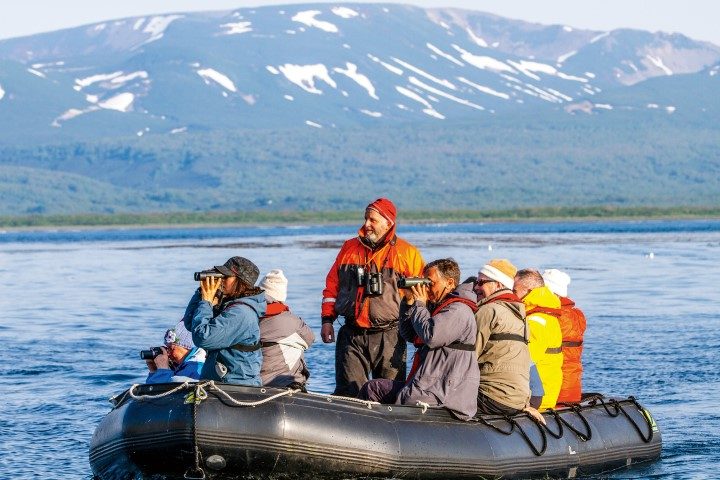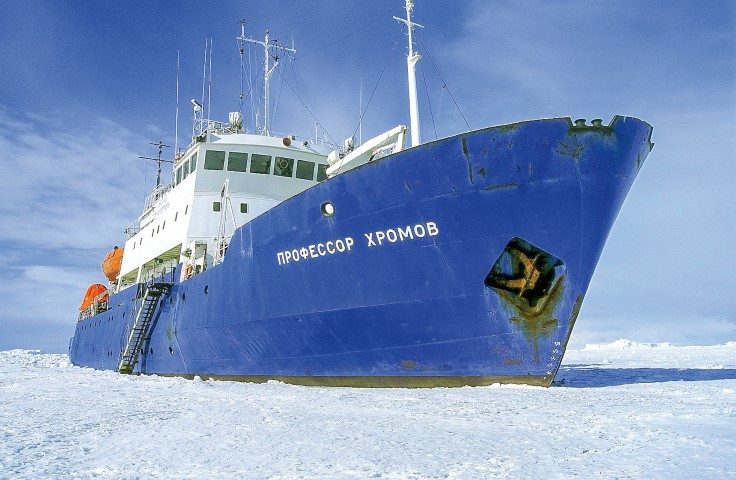

Russ has spent more time in this ocean than most and has shown more people its beauty than anyone else I know. To say he is a passionate advocate for Southern Ocean wildlife conservation is the understatement as wild as a wandering albatross.
Russ’ story starts not in the depths of a Southern Ocean gale but on the banks of the Waimea River near Nelson. He was a farmer’s son who had a healthy fixation on the birdlife of the river.

In the early 1960s a local contractor excavating gravel was asked by a small boy not to work near a pied stilt nest. It was a first attempt at conservation and the beginnings of a life that would be dedicated to opening awareness of the wildest and loneliest reaches of the planet.
Russ’ youth was spent between his desire for the outdoors and enduring the stuffy rigours of Waimea College. When the principal of the college suggested he might be wasting his time in the classroom, Russ took the hint and left school.
While expectation was that he would go farming, it was his passion for wildlife that drew him into applying for a Wildlife Service internship. The Wildlife Service was a small department under the Department of Internal Affairs and as it happened a breeding ground for most of the great names in New Zealand wildlife conservation.
In 1972 when a fellow trainee pulled out of the New Zealand, Australian and United States Auckland Island Expedition, Russ was asked to join for a three-month stint on the Sub-Antarctic Island. “I loved every minute of it. Tears streamed down my cheeks when we left and I promised myself I would return,” he says.
It was the first of many expeditions to the islands and it was where Russ earned the nickname of ‘The Evinrude Cowboy’ for his abilities as a Zodiac helmsman among the big swells and treacherous coastlines of the Southern Ocean.

His tenacity got him noticed and he was part of some ground-breaking teams that worked on saving the Chatham Island black robin and the kakapo and the Campbell Island teal.
In the late 80s, the Wildlife Service was absorbed into what would become the Department of Conservation. With the focus moving away from fieldwork to paperwork and a young family to feed, Russ made the unlikely break into the world of theology.
He studied at Knox Theological College at the University of Otago and it was during his university holidays that he took up work as track warden and as co-coordinator of the National Parks and Reserves Summer Holiday programme in Dunedin. This work sparked an idea to form a company taking nature-loving tourists to Fiordland by launch.
“These early expeditions reconnected me with my love of the ocean. They focused my thoughts on the Sub-Antarctic and how much I would enjoy sharing these islands with visitors,” he says.
“We operated our first expedition to the Auckland Islands for a group of penguin lovers from Japan. We combined that cruise with a census of the rockhopper penguin colonies on the Auckland Islands.”
This theme of tourists and travellers making a valuable contribution to conservation continues to the present day and is at the core of what would become Heritage Expeditions.

Finding suitable charter ships for the Sub-Antarctic was always a challenge, as the Southern Ocean demands a lot from a vessel. Initially Heritage Expeditions used the Acheron, the vessel Russ had first travelled to the Auckland Islands in 1972.
When the Acheron became too small, the company switched to Pacific Ruby (nicknamed the Rolling Ruby) chartered from Youth with a Mission. She spent half the year spreading the gospel in the heavenly waters of the South Pacific, the rest as a charter ship to Heritage Expeditions battling with the hellish seas of the Southern Ocean.
“Those early years were fun. We kept one step ahead of the authorities who were determined to put us out of business.”
In 1993 the business took a large step up when it signed the charter for a 48-berth Russian research ship Academic Shokalskiy. This required a guarantee of one hundred days work each summer, which forced the company to expand into taking expeditions to the Ross Sea and East Antarctica.
With the bank not interested in such a high-risk activity, the venture was funded in the first season on cash flow. The Shokalskiy quickly became a feature of the Southern Ocean, as did the entire Russ family with Russ’ wife Shirley running logistics and his sons Aaron and Nathan taking to expedition travel at an early age.
Ten years later a new charter agreement was signed on Shokalskiy’s sister ship Professor Khromov and Russ began researching the possibility of running expeditions to the Russian Far East.
A few companies had tried and failed to get a foothold in eastern Russia, as the area had always been off-limits during Soviet times, due to the presence of military bases and the proximity to the United States.
At the best of times doing business in Russia is a complex and frustrating undertaking and it was pure tenacity and hard work that got them there.
“They say in Russia that nothing is allowed but everything is possible,” says Russ. “I think it sums things up well. There are a lot of rules and regulations, and it can drive you crazy sometimes, but there are so many opportunities. It’s an incredible part of the world.”

His last voyage under Heritage Expeditions docked in Lyttelton Harbour earlier in 2018. It marked a 40-year career in the wildest places on earth and also set in train his retirement project.
Not comfortable with a lie down and a cup of tea kind of retirement, Russ has spotted a niche in the market for smaller groups focused in remote locations with an emphasis on hands-on conservation. With that in mind he has commissioned the construction of an 80-foot, sail-assisted expedition vessel named Strannik, which is due for launching later this year.
It is a clear case of back to the future for Russ. “Unless we share the wilderness and wildlife of this planet’s land and oceans with people we will never get their support for conservation. Conservation grows out of communities and we must share it in a way that is both responsible and informative.“ While it is one sailor’s mantra it is quite possibly a sketch of our future on this planet.




